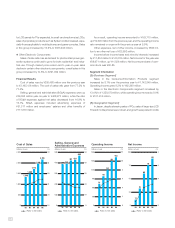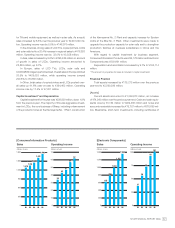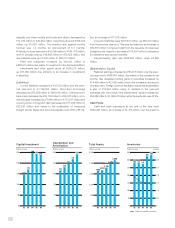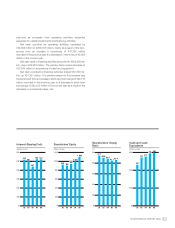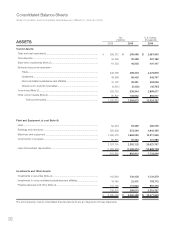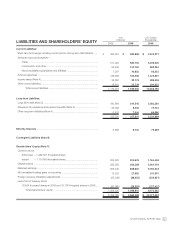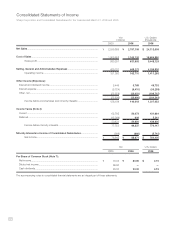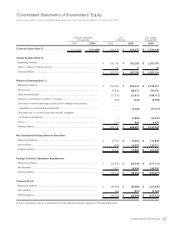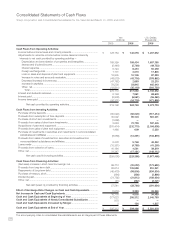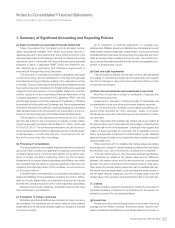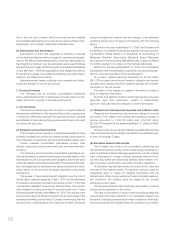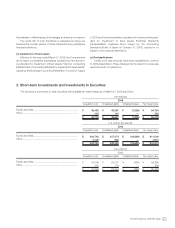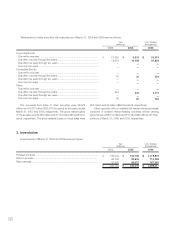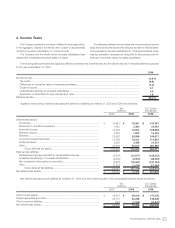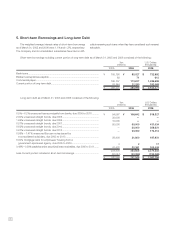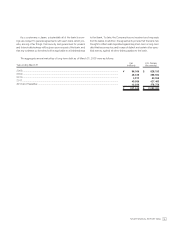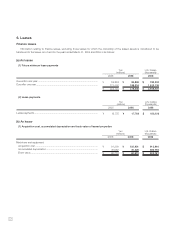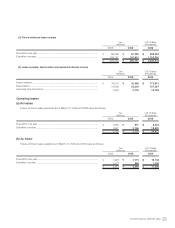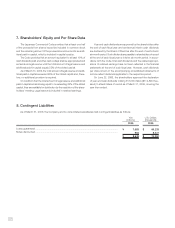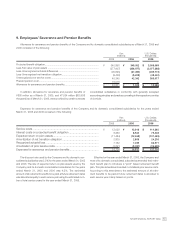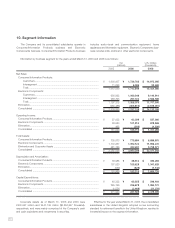Sharp 2006 Annual Report Download - page 42
Download and view the complete annual report
Please find page 42 of the 2006 Sharp annual report below. You can navigate through the pages in the report by either clicking on the pages listed below, or by using the keyword search tool below to find specific information within the annual report.
41
first-in, first-out cost or market. Work in process and raw materials
are principally stated at the current production and purchase costs,
respectively, not in excess of estimated realizable value.
(h) Depreciation and amortization
Depreciation of plant and equipment is primarily computed
on the declining-balance method, except for machinery and equip-
ment in the Mie and Kameyama plants, which are depreciated on
the straight line method, over the estimated useful lives. Buildings
acquired by the Company and its domestic consolidated subsidiaries
on and after April 1, 1998 are depreciated on the straight-line method.
Properties at overseas consolidated subsidiaries are mainly depre-
ciated on the straight-line method.
Maintenance and repairs including minor renewals and better-
ments are charged to income as incurred.
( i ) Accrued bonuses
The Company and its domestic consolidated subsidiaries
accrue estimated amounts of employees’ bonuses based on esti-
mated amounts to be paid in the subsequent period.
( j ) Income taxes
The asset and liability approach is used to recognize deferred
tax assets and liabilities for the expected future tax consequences
of temporary differences between the carrying amounts of assets
and liabilities for financial reporting purposes and the amounts used
for income tax purposes.
(k) Severance and pension benefits
The Company and its domestic consolidated subsidiaries have
primarily a trusteed noncontributory defined benefit pension plan for
their employees to supplement a governmental welfare pension plan.
Certain overseas consolidated subsidiaries primarily have
defined contribution pension plans and lump-sum retirement ben-
efit plans.
The Company and its domestic consolidated subsidiaries pro-
vide the allowance for severance and pension benefits based on the
estimated amounts of projected benefit obligation and the fair value
of the plan assets at the balance sheet date. Projected benefit oblig-
ation and expenses for severance and pension benefits are deter-
mined based on the amounts actuarially calculated using certain
assumptions.
The excess of the projected benefit obligation over the total of
the fair value of pension assets as of April 1, 2001 and the allowance
for severance and pension benefits recorded as of April 1, 2001 (the
“net transition obligation”) amounted to ¥69,090 million. The net tran-
sition obligation is being amortized in equal amounts over 7 years
commencing with the year ended March 31, 2002. Prior service costs
are amortized using the straight-line method over the average of the
estimated remaining service lives (16 years) commencing with the
current period. Actuarial gains and losses are primarily amortized
using the straight-line method over the average of the estimated
remaining service lives (16 years) commencing with the following
period.
Effective for the year ended March 31, 2006, the Company and
its domestic consolidated subsidiaries adopted the new account-
ing standard “Partial Revision to Standards for Accounting for
Retirement Benefits” (Accounting Standards Board Statement
No.3 issued by the Accounting Standards Board of Japan on March
16, 2005), resulted in no impact on the financial statements.
Effective for the year ended March 31, 2006, the consolidated
subsidiaries in the United Kingdom adopted a new accounting stan-
dard for retirement benefits in the United Kingdom.
As a result, retained earnings decreased by ¥4,765 million
($41,078 thousand) since the net transition obligation and actuar-
ial losses were charged directly to retained earnings with immate-
rial impact on the net income.
The effect of this change on segment information is stated in
Note 10. Segment Information.
Directors and statutory auditors customarily receive lump-sum
payments upon their termination, subject to shareholders’
approval. Such payments are charged to income when paid.
( l ) Research and development expenses and software costs
Research and development expenses are charged to income
as incurred. The research and development expenses charged to
income amounted to ¥148,128 million and ¥154,362 million
($1,330,707 thousand) for the years ended March 31, 2005 and 2006,
respectively.
Software costs are recorded principally in prepaid expenses and
other and amortized by the straight-line method over estimated use-
ful lives of principally 5 years.
(m) Derivative financial instruments
The Company and some of its consolidated subsidiaries use
derivative financial instruments, which include foreign exchange for-
ward contracts and interest rate swap agreements, in order to hedge
risks of fluctuations in foreign currency exchange rates and inter-
est rates associated with assets and liabilities denominated in for-
eign currencies, investments in securities and debt obligations.
All derivative financial instruments are stated at fair value and
recorded on the balance sheets. The deferred method is used for
recognizing gains or losses on hedging instruments and the
hedged items. When foreign exchange forward contracts meet cer-
tain conditions, the hedged items are stated by the forward
exchange contract rates.
The derivative financial instruments are used based on internal
policies and procedures on risk control.
The risks of fluctuations in foreign currency exchange rates and
interest rates have been assumed to be completely hedged over
the period of hedging contracts as the major conditions of the hedg-
ing instruments and the hedged items are consistent. Accordingly,


